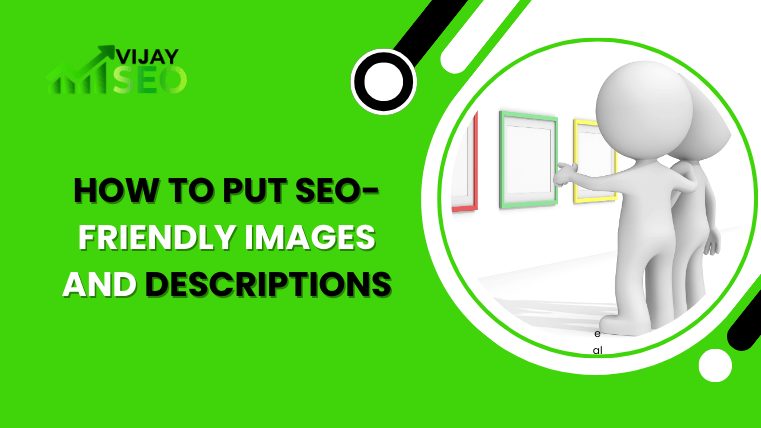How To Put SEO-Friendly Images And Descriptions
In the ever-changing world of online content, optimizing your website for search engines is critical to attracting organic traffic. One frequently overlooked aspect of this optimization is the use of SEO-friendly images and descriptions. In this guide, we’ll look at the importance of visual content in SEO and offer practical advice on how to improve your website’s visibility through image optimization.

Understanding the Role of Images in SEO
Comprehending Image SEO:
Before beginning the optimization process, it’s critical to understand how search engines interpret images. Learn about alt text, file names, and other important elements that help make your images search engine friendly.
The Impact on User Experience:
Examine the relationship between user experience and SEO. Discover how high-quality, relevant images can increase user engagement, lower bounce rates, and ultimately improve your website’s search engine rankings.
Tips for SEO-Friendly Images
Choosing the Right File Format:
Discuss the importance of selecting an appropriate file format for your images. Learn about the differences between JPEG, PNG, and other formats and how they affect image quality and website loading speed.
Image Compression Techniques:
Learn how to balance image quality and file size using compression. Discover tools and techniques for reducing file sizes while maintaining image quality.
Crafting Descriptive File Names:
Consider the significance of using descriptive and keyword-rich file names for your images. Understand how this simple step can help improve your search engine rankings.
Utilizing Alt Text Effectively:
Learn about alt text and how it helps search engines by providing context. Learn how to write meaningful, descriptive alt text that improves accessibility and SEO.
Implementing SEO-Friendly Image Descriptions
Learn how to strategically place keywords in image descriptions to naturally integrate them. Learn how using relevant keywords can boost your image’s visibility in search engine results.
Providing Context with Captions:
Discover how image captions affect user engagement and SEO. Learn how to write informative and engaging captions to accompany your images.
Image Schema Markup:
Introduce the concept of image schema markup and its role in providing more information to search engines. Investigate how using schema markup can improve the way your images are displayed in search results.
Monitoring and Iterating
Regular Audits and Updates:
Highlight the importance of auditing and updating your images on a regular basis for SEO purposes. Investigate tools and practices for monitoring the performance of your images and making necessary changes over time.
By integrating SEO-friendly images and descriptions into your website, you not only enhance your visibility in search engine results but also provide a better user experience. Follow these tips to ensure that your visual content becomes a powerful asset in your overall SEO strategy.
FAQs:
Why is image optimization important in SEO?
Image optimization is critical for SEO because search engines rank pages based on both text and image content. Optimized images speed up page loads, improve user experience, and contribute to a website’s overall SEO performance.
What are the main components of an SEO-friendly image?
An SEO-friendly image should have a relevant filename, descriptive alt text, and the correct image size. The filename should be concise and contain relevant keywords. Alt text provides context for search engines and helps users with visual impairments.
How do I select the appropriate file format for SEO-friendly images?
JPEG is best for photographs and gradients, whereas PNG is better for images with transparency or a limited color palette. WebP is a newer format that combines high quality with smaller file sizes, resulting in faster page loading.
What is the meaning of the image alt text?
Alt text (alternative text) is important for SEO because it describes the contents of an image. Alt text is used by search engines to understand an image’s context, making it an important ranking factor. Ensure that your alt text is descriptive and contains relevant keywords.
How do I compress images without losing quality?
Use image compression tools like TinyPNG, ImageOptim, or Adobe Photoshop. These tools reduce file sizes while maintaining image quality, resulting in faster loading times and better SEO performance.
